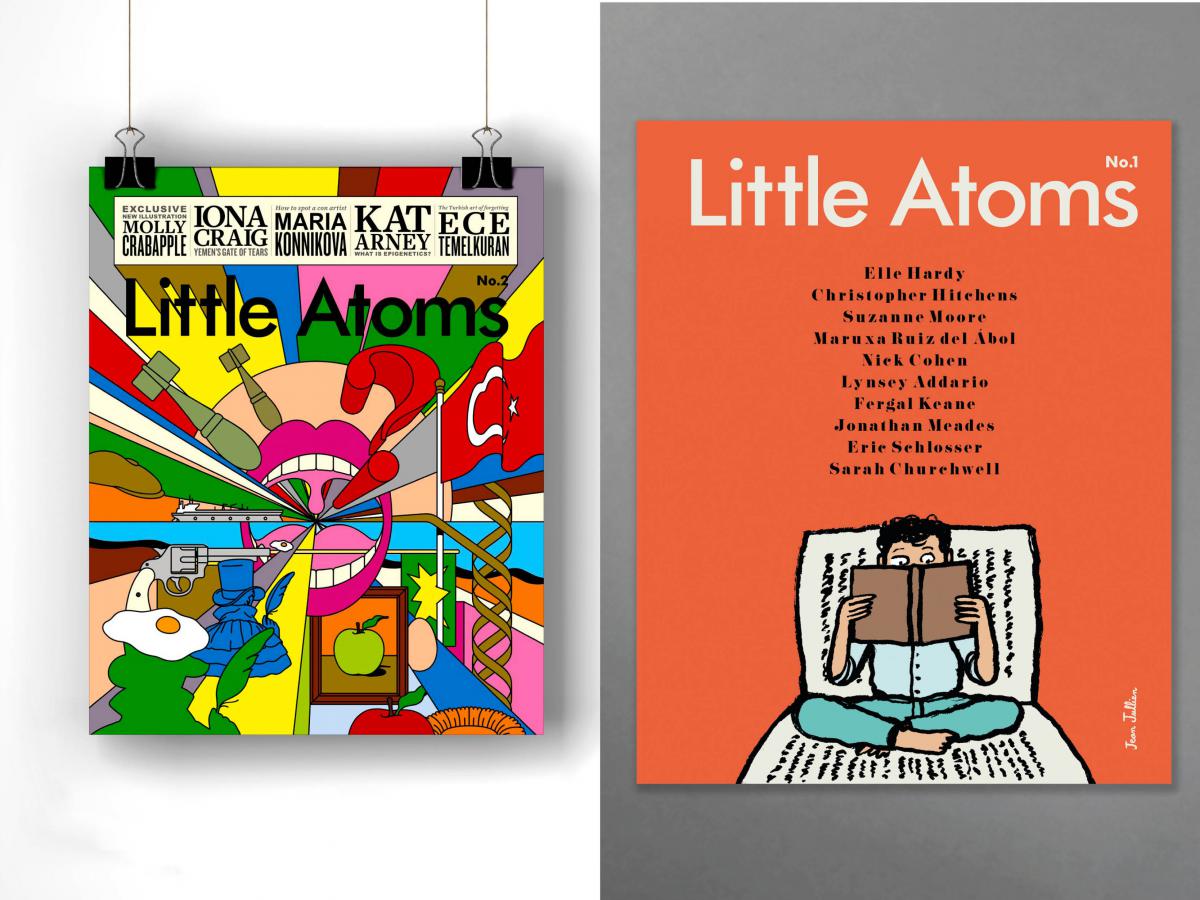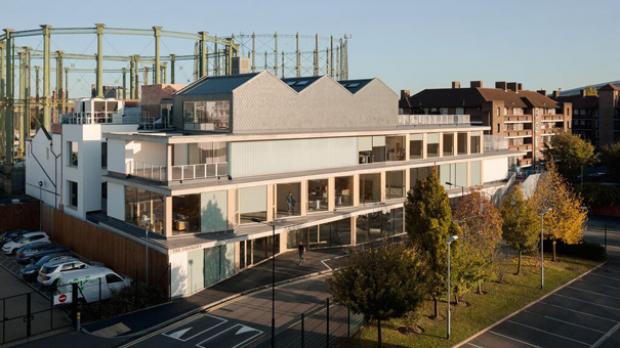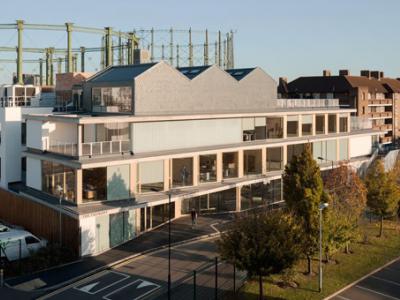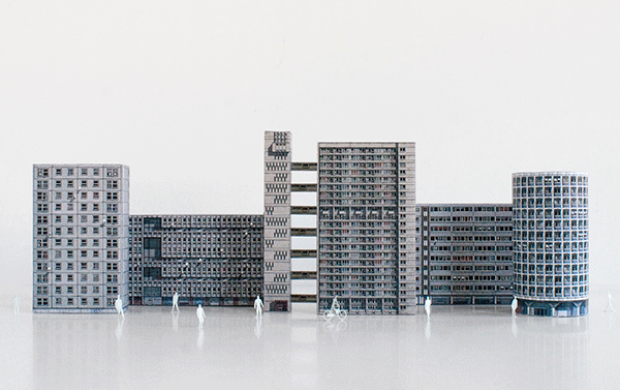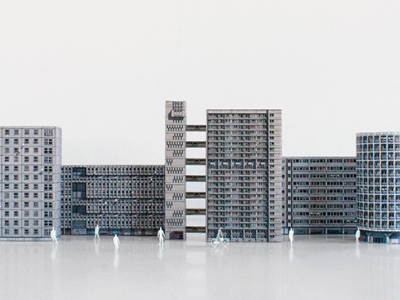A design for life
Little Atoms: Cities such as Coventry and Plymouth and Newcastle and Glasgow were incredibly heavily bombed during the second world war, but they were also places where there were vast tracts of slums. One architect said the Blitz was the great opportunity!
John Grindrod: There were blitzed cities like Plymouth and Coventry I write about particularly. They’re very different. The father of town planning in Britain was Patrick Abercrombie, who was based at Liverpool University. He was the person asked to write a lot of the plans for rebuilding towns and cities after the war, including the London one, and Hull. He does one for Plymouth and the one he does for Plymouth is really quite old school. It’s very 1930s, and as a result when you look at Plymouth it’s all built it on what they call “axial principles”, so everything is on straight lines and very impressive, and you have this huge boulevard leading down to the sea, and Armada Way, which is brilliant but also a massive wind tunnel, so not brilliant at the same time.
This is really a hangover from the garden city idea isn’t it? Big, wide spaces between buildings, which is something that there was a lot of opposition to because it makes places a bit sterile.
That sort of really wide boulevard that they built there slightly went out of favour because it was seen as a triumphalist, it was all a bit Albert Speer-y. After the war not really in favour.
So Plymouth gets built in this very Portland stone sort of white, quite 30s style. Anybody that’s seen Senate House in London or buildings of that era, that sort of Neo-Georgian stuff, will recognise the buildings in Plymouth because it is of that inter-war style of architecture more than it is strictly that modern. In Coventry on the other hand, the architects there were much more keen on doing something quite different, and although initially their plans have got a lot of those pre-war quite axial stuff going on, that develops a lot more than it does in Plymouth. So Plymouth is a very pure town in the way that it’s been built. It had singular vision and it’s built in that singular way and as a result it’s absolutely brilliant. It’s amazing to walk round because it’s almost like a model village. Everything fits.
Coventry has a lot of stuff that changes over time, so they go from that axial idea to stuff being curved, boulevards and things in the way to break up the view so that you walk round corners and have more surprise: this idea of townscape, as it was called, where you don’t reveal everything at once, but it’s all about a more intimate human scale.
A big symbol of the rebuilding of the whole country was rebuilding of the cathedral at Coventry.
Absolutely. It had been completely devastated in the Blitz and burned out. Basil Spence is the architect who wins the competition to design Coventry Cathedral. He designs this quite peculiar building, but the great thing about it is that it leads you from the ruins into the new building, and you have this amazing screen with these ghostly figures that link you from the old to the new. I find it a very beautiful and very powerful building. Whenever I go to Coventry I always go into the cathedral, and I’m about as spiritual as a brick. And even though at the time people were going, “it looks like a jam factory”, I think it’s a wonderful building.
New Towns that started to be built after the war, such Harlow in Essex and Cwmbran in Wales, which take different approaches. They’re completely different places but are two where you can see those ideas that remained from the garden cities.
Yes absolutely. So garden cities were a thing had been basically invented by a guy called Ebenezer Howard in 1898 in a book, Garden Cities Of To-Morrow.
“To-morrow”. I like how it’s called “To-morrow”.
Yes exactly, not enough hyphens in words these days. He was reacting against the legacy of the Industrial Revolution, which had meant that cities had grown up with factories in the middle of them and were crowded with workers’ houses all round the edges; terribly built places with no sanitation and really terrible health.
And so he’d had this idea that you could build “garden cities”, which would be places where you’d have a little neighbourhood, you’d surround your neighbourhoods with a lot of green, you’d zone away your factories from the housing, and you’d give people places to play and enjoy the countryside. It was all about having the best of the country and the best of the city and putting them together. Then you’d have your little green belt round the outside of it and maybe eventually link up a load of these garden cities and create a really big one: it would all be very, very green. There were two built, private developments essentially. Letchworth being the first one and then Welwyn.
The new town idea came about during the war with planners such as Patrick Abercrombie wanting to move people away from city centres and depopulate overcrowded bits of the city like east London or the Gorbals in Glasgow.
Harlow was built to alleviate the East End of London. That was a masterplan by Frederick Gibberd. He was an architect-planner – he was able to do both things – so he designed a lot of the buildings in Harlow as well as planning the whole place, which is very unusual. He lived there as well so he was very much part of that story: a lot of early Harlow feels like one man’s grand plan to make this thing happen.
Harlow had the first point block building in Britain. Point blocks were a Swedish invention. They’re a block of flats where you have the lifts or the stairs in the middle of it and flats going off them round the edge. We recognise those square towers, we see them everywhere now. The first one’s built in Harlow, The Lawns. There was a lot of fuss at the time about it because when people talked about garden cities, everyone would live in a house. The idea that you would build a new place in the countryside and you’d put flats in it? People were outraged. Flats just weren’t a popular idea at all. But he partly built it as a landmark. There aren’t really that many blocks of flats in Harlow. He built it so that you could orientate yourself in this new environment with a tall building.
One of the things he was very keen on was “green wedges”, as they came to be known. He hired the mother of landscape architecture, Sylvia Crowe, and she came in and designed parks throughout Harlow. These green spaces were meant to break up the different neighbourhood units so that the individuals in different houses could spill out into these communal areas. It was this vision of everybody living a bit in the country and not, a completely different place from where they’d come from.
Cwmbran, the new town near Newport, is a different proposition again, because there are more landscape constraints.
Yes, and it’s a lot smaller than Harlow. It’s got a very weird inward looking town centre right in the middle of it with a ring road round it, and the neighbourhood units are spread out surrounded by big hills. When you see sci-fi films and people have terraformed a world it looks exactly like Cwmbran. It’s very odd standing on that multi-storey car park in the middle of it looking around thinking “this landscape is amazing” and this place actually feels quite small underneath the big hills and the big sky that you’ve got there. Whereas Harlow feels very bucolic English countryside.
A lot of people thought that the garden cities, – big, wide spaces and green wedges – were distancing people from each other ane making community spirit less possible.
The architectural press particularly ripped into the early new towns like Harrow and Stevenage. They called it prairie planning, when people were so isolated from one another because you just had endless lawns. One of the weird things about Harlow is that everywhere is mown within an inch of its life. I think a lot of Sylvia Crowe’s landscape architecture is suffering from a bit of over-mowing. It probably wasn’t meant to be quite that harsh.
The entire town centre of Cumberbauld was built as one building
There was a next generation of architects who wanted to make something much more urban. They wanted to put people together and not have them spread out in this sort of faux-bucolic manner.
Cumbernauld was part of this wave. One of the interesting things about Cumbernauld is that they built the entire town centre as one building – well that was the idea. We have Britain’s first and probably only real megastructure. Geoffrey Copcutt, who designed it, was really uncompromising. It was going to be built in five stages. It has a road going through it. He had this vision that in the future it could turn into a giant vending machine, sort of like a giant drive-thru that did everything: you just drove your car through it and people shoved mattresses through your window.
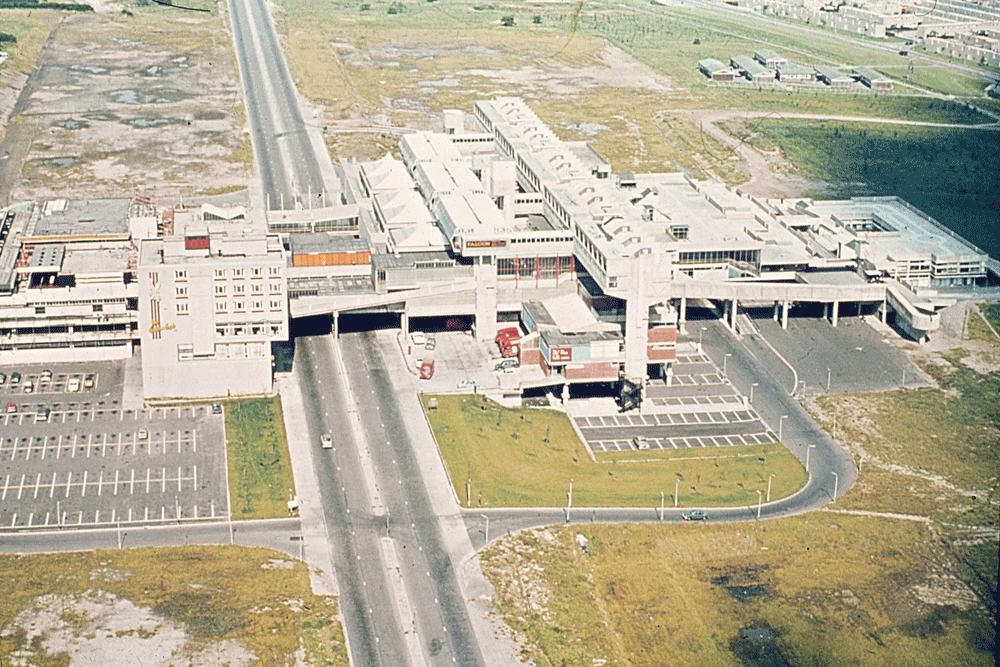
So Cumbernauld has this super urban spaceship in the middle of it and it’s built on a very windy, exposed ridge. It’s quite a tough place and it wasn’t sealed off from the elements so it was a bit of a terrifying wind tunnel for people shopping there. But round the outside of that they’ve still kept with the idea of neighbourhood units that you had in Harlow, the idea was that you could walk everywhere and you weren’t so far away from everything that you had to have a car. It means that the buildings in Cumbernauld are a bit more experimental. You get moving into that late 60s, early 70s sort of era of housing, you get a lot of amazing mono-pitch roofs, you get buildings that look like a modernist fishing village. Everything’s grey and hard-wearing looking and small and huddling away from the wind.
Cumbernauld seemed to me the most extreme example the idea that men – and it was always men – were forcing their will onto the populace, wanting to have control over people’s lives.
There was a lot of stuff about the Germanistic way of altering people’s lives by engineering the way that you move around a town or you interact with other people. If you’re building a whole new town you have to think about all that stuff. You do have to think about how people are going to interact with one another. Where are strangers going to meet and have a conversation? Where are you going to take your dog for a walk? All those things have to be built; they’re not buildings, they’re not roads, they’re not shops, they’re the other places that we don’t really think about.
But it isn’t always a story about men. One of the really interesting things that I found in this period is the amount of very senior influential women that there were doing very big schemes and so you’ve obviously got Alison Smithson, part of the amazing duo [Alison and Peter Smithson] that were probably the most feared Brutalists; you had Mary Medd who helped design the amazing pre-fabricated schools in Hertfordshire, a whole new way of building public buildings. And Dame Evelyn Sharp from the Ministry of Housing who was Britain’s first female permanent secretary, upon whom apparently Sir Humphrey is based on in Yes, Minister. I’m completely obsessed with her because she just seems to be the most extraordinary character. She demanded that everybody called her the Dame, she ran that ministry with a rod of iron, she didn’t take any shit from her ministers and she really, really, made sure that things got done. She loved Cumbernauld. She was all about Cumbernauld. She hated Harlow. She thought Harlow was just milksop rubbish. She was like: “No, I want Brutalism, I want something more urban.” She was uber-modernist and she wanted the most audacious stuff built. Cumbernauld is the most audacious stuff: in town planning terms it’s Concorde. It’s as extreme as you got in the post-war period.
A different way that new towns could have been done is New Ash Green in Kent. Eric Lyons envisioned this new way of living.
New Ash Green was an amazing hippy vision of Scandinavian-influenced village life built in the Kent countryside. But actually only a fifth of it as envisaged by Lyons ever got built because Span, his company, went bankrupt. When you go round it now, four-fifths of it are horrible Bovis red-brick nonsense and then you’ve got these absolutely stunningly beautiful Span houses which have all got glazed walls. Every one of them looks like an architectural journal wet dream.
Inside as well?
Teak. All about teak. So many of the fixtures and fittings in there are teak. Teak or asbestos. They’re absolutely lovely. Utterly baffling to walk around. I could not find my way round but really lovely and loads of green space. This is a private development and private developers normally don’t put any, or very much, green space in because they want to cram in as many houses as possible, which is what’s happened in the new bits of New Ash Green. But Eric Lyons was really keen on landscape architecture and made sure that there was an enormous amount of green in there. The whole place feels very calm and it’s got a lovely hippyish vibe about it still.
I want to look at Richard Seifert and his amazing towers. One of my favourite buildings in London is his Space House. But let’s talk briefly about the story of Centrepoint, which is his other iconic building.
Centrepoint was a development by Harry Hyams, the daddy of developers as he was known, this mysterious man who’s still alive and never gives interviews, never has. He agglomerated loads of little sites as they came up around St Giles and then suddenly, “Oh!” Harry Hyams has bought this whole area.
He proposes to put this tower there. The council’s not so keen unless he does a big road scheme there for them, a roundabout So it becomes this tower sitting on a roundabout.
And then it just lay empty for 10 years. The rental price kept going up and up and nobody moved in, because Hyams said: “I want a corporation, I want one person to move into this building, I don’t want it split up into loads of different lets.” And because no one organisation wanted to move in, it just lay empty for years. Seifert absolutely got it in the neck from everybody. There’s an amazing clip of Kenneth Williams talking about it on the Parkinson show. It became a huge national outcry from which the Centrepoint housing homelessness charity springs. At the same time as all this was going on, rents suddenly start going up in London, there is a housing crisis, there aren’t enough places for people to live and there’s this monolithic office block right in the middle of it that’s empty for a decade. There’s this great mini-heist where somebody infiltrates the security firm. They all go in one night and suddenly Centrepoint’s occupied by all these protestors and it takes ages to get them out. Hyams is quite shocked by this because I think up until this point it’s all been quite abstract. And then suddenly they were real people doing real stuff in his real building. It is a turning point. Loads of his buildings had been empty at that point; Space House was another one that had been empty. A couple of years later they were all let, they were all full and this weird cat-and-mouse game that had been going on was over.
We get to the point where the post-war dream and consensus starts to sour. There was obviously Thatcherism and the lowering of the idea of social housing and the selling off of the social housing stock. But there’s a couple of really symbolic things, or a symbolic happening, and a symbolic person. I’m talking about Ronan Point and John Poulson.
Poulson starts as an architect and is rubbish. He’s got no eye, nobody really thinks much of him. He’s got this small architectural practice in Pontefract. And by the end of the 60s he’d got the largest architectural practice in Europe in Pontefract. All of these young architects from all over the world all working cheap.
It turned out that Poulson has been openly bribing councillors all over Britain to let him design and build stuff. He had his own building company as well, so not only was he designing the buildings he was then building them, which was unheard of. In fact there were laws in place to stop you doing that really. So he was flouting a bazillion laws and doing really outrageous things. It ends up in a really messy court case in 1974, and probably the biggest casualty of it is T Dan Smith.
T Dan Smith was “Mr Newcastle”. He was the Labour councillor who basically dragged Newcastle into the modern era from the mid-50s onwards, when he’d been looking after housing for the council. He’d got loads of flats built on an area of slums in Cruddas Park.
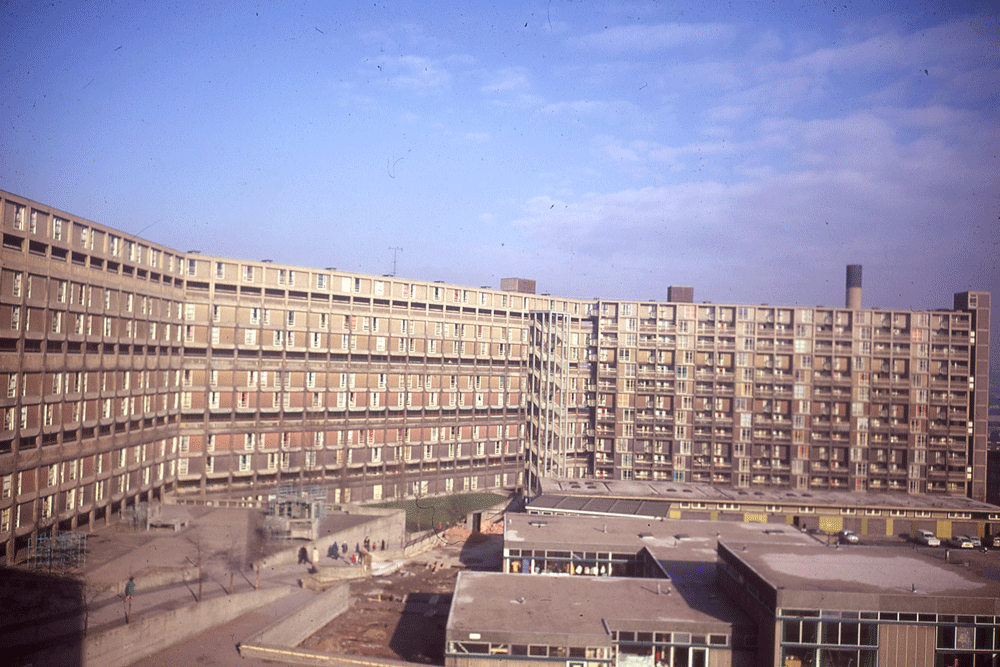
And T Dan Smith was this very charismatic figure. His and Poulson’s story is so mythologised now because it is outrageous. They became mates and immediately realised they could work together in quite a dodgy way. But Smith weirdly seemed to be always trying to do the right thing, but in such an outrageously dodgy way. You just think well, can the two things go together? They obviously went together for about 15 years and then it all went horribly wrong and they both end up going to prison and it’s awful.
In some cases the planners just had ideas that could never really be translated into real life
Smith has had three different trials in the early 70s. There were a lot of things that he was doing that were wrong. So both of them were going to get caught out. The thing that caught Poulson out was his company going bankrupt because he’d given away so much of his money to bribe people, which really is poetic justice.
This was the era when the idea that tower blocks, is just completely anathema and the wrong way and so many of those, not just cheaply badly-built tower blocks, but a lot of the really good, iconic tower blocks have subsequently been either completely destroyed or reclad or repurposed. A lot of that idea about tower blocks being so bad obviously comes out of the fact that they were cheaply built, shoddily built, quickly built by people who were being bribed as well. And then of course, subsequently mismanaged or just not managed at all and deliberately social engineered to have extremely deprived people living in them as well. That strategy is the thing that makes tower block living not particularly pleasant, rather than the tower blocks themselves, right?
One of the things that happened with the right-to-buy policy in the 80s particularly was that people bought houses. It’s always been more difficult buying flats, it’s always more difficult getting a mortgage and all that sort of stuff. So as people gradually started to buy up all the council houses that had been built in the post-war period the council housing pool got smaller and smaller, so you were getting increasing concentration of poor people living together in flats. You just end up with blighted areas, full of people who were trapped.
Then partly in some cases the planners just had ideas that could never really be translated into real life. If you go round Glasgow a lot of those schemes are so massive, and they expected people that had been living in little houses or tenement blocks to suddenly completely transform their lives and live on the 18th storey of a block of flats. That is, psychologically, a massive deal and very little is made of it.
There’s very little sociology that goes on at the time and when it does happen it’s already late because they’ve already been built. Rather than testing out a lot of stuff and easing people in and working out what the best way is of doing this, so much is built so quickly because both Labour and Tories are very keen on building as many houses as possible. The best way of getting that done is using system building, which is basically bolting together big panels of concrete. And then you end up with the disaster that happened at Ronan Point [in east London in 1968] which was made out of the system that was only ever meant to be built up to six storeys, I think it was, and was three times that. And they had gas which was probably not a great idea. So Ivy Hodge, a woman living in one of the top flats, went to light her hob one morning to make a cup of tea and the gas exploded. It blew out the wall in her front room which was next door, on the corner of the block, and then the whole thing collapsed, that whole corner.
Luckily this was at 5am and hardly anyone was up, so there were a couple of fatalities, but it could have been much worse. Had it happened during the day everyone would have been up and about in their living rooms. When they investigated to see how these blocks had been bolted together it was revealed that there were so many faults in the construction of them, and this system was never designed to do the thing that it ended up being used for. It was terrible that the company allowed a council to build something so massive with something they knew wasn’t suitable.
We seem to have a major housing crisis now. What could we learn today from the mistakes that were made in the past?
We should just be a bit more ambitious. One of the lovely things is just looking at how massively ambitious people were. And of course on occasion that goes horribly wrong and on occasion you produce something that’s so magnificent that everyone loves it now. We live in such a timid age. Unless you’re a private developer who wants to make a shiny office block, there isn’t really a lot of desire to build much else at the moment. People are always talking about planning regulations needing overhauling or whatever, but I think just a bit of ambition and vision and fewer focus groups is probably the way forward: somebody having a good idea and pushing it forward is what’s needed.
(All images JR James Archive/Flickr)
John Grindrod’s Concretopia, A Journey Around the Rebuilding of Postwar Britain is available now

